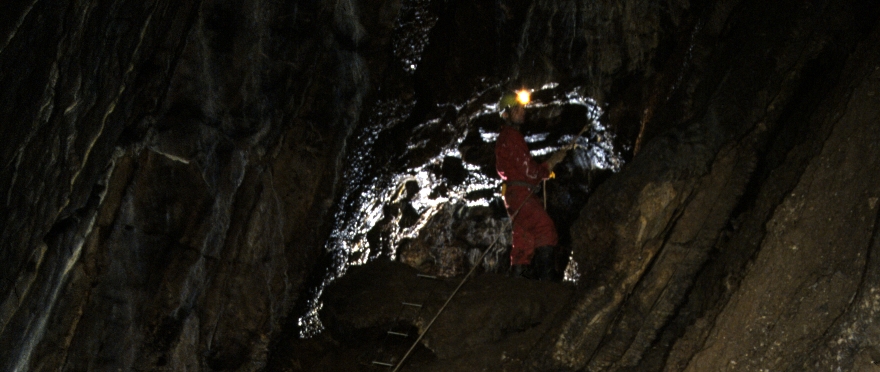How Old is the Cave?
Bristow argued, using comparative dating techniques, that the cave was very old, probably Permo-Triassic. This conclusion was reached on the basis that the cave pre-dated the mineralisation and also an episode of faulting which affected the mineral deposits. This latter is seen in the First Chamber, although doubt has recently been cast on the significance of this fracture (W.I. Stanton, pers comm). Both these events would have to be pre-Liassic, as the faulting affecting the cave did not seem to affect the Rhaetic clays overlying it. Bristow also argued that it was highly unlikely that a solutional cavity would be formed in a limestone deposit completely buried beneath a thick cover of Mesozoic clays and it is certainly true that this area was completely covered by Mesozoic sediment until the early Pleistocene.
Whilst it is true that Permo-triassic caves are known in this area, (Ford, 1989, Halstead and Nicoll, 1971) most of them have been infilled by Triassic deposits. One of the most striking things about Pen Park Hole, if it is this old, is its virtually complete lack of surface derived sediment infill. These other caves would have been formed by meteoric waters at a time when the Carboniferous limestone formed uplands, or an archipelago of islands in a shallow sea (Marshall and Whiteside, 1980). This is not the case for Pen Park Hole, as it is shown to have been formed by geothermal waters rising from below, rather than meteoric waters from above and it is likely that the presently known parts of the cave did not have a direct connection with the Rhaetic sea floor. All the entrances known in historical times are the result of surface denudation and quarrying activities.
The Pleistocene, probably Devensian, faunal collection that was presented to the Natural History Museum in 1884 by Spencer Perceval (R.M. Jacobi, pers comm.), and is listed as having come from Pen Park cave, or Pen Park fissure (Reynolds, 1931, 1938) has no direct connection with Pen Park Hole. It was discovered in another, separate, cave in a nearby quarry. (Anon, 1883). This may have been Jill’s Cave (Rollason, 1963) situated in the bottom of a quarry about 250 m west of Pen Park Hole. This cave, along with the entire quarry, was filled in around 1960 and few records remain.
It is therefore possible to argue that the cave could quite easily have been formed whilst the limestone was buried, which increases considerably the timescale over which this could have occurred. One argument against deep burial, however, is the evidence for a distinct water surface within the cave, above the level of the massive calcite deposition on the one hand and allowing room for steam condensation-corrosion of the roof above hot pools, on the other. If there was no direct connection between the cave, as now known and the surface at that time then the vent for the hot spring may have been further to the east, possibly following the now lost passage (see above) to the edge of the limestone outcrop. Thus Bristow’s conclusion of a late Triassic date for the cave remains a valid possibility. A fluid-inclusion study of the calcite might give some information as to the temperature and by implication the depth, at which this deposit was emplaced. It is also possible that the result of a lead isotope determination of the galena deposit would allow it to be compared with samples from the Mendip ore field to estimate whether they had a similar origin. A fuller study of the minerals in this, and other, Bristol caves is to be undertaken by other workers.
Kellaway (1967) describes a concordance between the distribution of galena veins in the Carboniferous Limestone of the Clifton Down plateau, approximately 4 km south of the cave, and the disseminated lead-zinc ores found in the Rhaetic clays and Keuper deposits. Alabaster (1982) interprets this to mean that these latter are ’exhalative deposits’, formed as a result of the discharge of warm, metalliferous springs onto the Rhaetic and Jurassic sea floor. A similar conclusion was reached by Hamilton (1966) about comparable deposits at Almondsbury, to the north. It would seem that Pen Park Hole is an ideal candidate for such a warm spring. This would also give a late Triassic, early Jurassic age for the cave’s major development and functioning. The limonite, however, may have been emplaced much later, the result of the downward movement of iron-rich waters during the Tertiary erosion of overlying Mesozoic strata.
A similar, hot spring origin has recently been suggested for the main fissure at Cromhall Quarry, some 17 km to the north east, by Simms (1990). There the sediment infill has been dated to the Triassic (Halstead and Nicoll, 1971), implying an earlier date for the formation and mineralisation of the cave and a much earlier date for the mineralisation than the mid-Jurassic date proposed for the Mendip lead-zinc mineralisation by Stanton (1981, 1991). This, again, is in line with Bristow’s proposed dating for these processes in Pen Park Hole.
It is now impossible to say what the source of the hydrothemal waters feeding this cave was. It is certain that there is no longer any contact with that source. Neither is it possible at present to give an absolute age for the cave. The massive calcite is unfortunately too old and too contaminated by lead to allow the successful application of Uranium series dating techniques.
The above conclusions about the formation, and especially the dating, of this cave are tentative. A fuller and deeper study of its geology may well lead to their being substantially modified.
